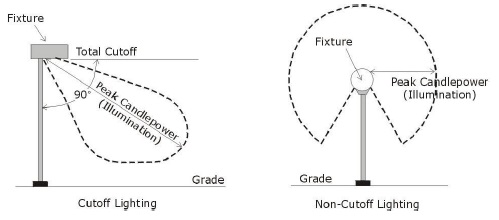(1) Purpose
The purpose of this section is to regulate light spillage and glare to ensure the safety of motorists and pedestrians, and to ensure lighting does not adversely affect land uses on adjacent properties. More specifically, this section is intended to:
(a) Regulate exterior lighting to assure that excessive light spillage and glare are not directed at adjacent properties, neighboring areas, and motorists;
(b) Ensure that all site lighting is designed and installed to maintain adequate lighting levels on site while limiting negative lighting impacts on adjacent lands; and
(c) Provide security for persons and land.
(2) Applicability
(a) General
The provisions of this section shall apply to the addition of any new light fixture on a lot or all development in the city except for:
(i) Lots with single-family and two-family dwellings, however, no such lot shall have lighting positioned so as to extend glare onto an adjacent property or a public right-of-way.
(ii) Existing athletic field lighting;
(iii) City-owned, city-operated, or city-maintained street lights located within a street right-of-way or other easement granted to the city; and
(iv) Lighting and fixtures approved as part of a Certificate of Appropriateness.
(b) Lighting Plan Required
An exterior lighting plan shall be submitted and approved as part of a site plan application or as necessary, a zoning permit or zoning compliance permit application (for changes of uses, additions, etc.).
(c) Lighting Standards
(i) No flickering or flashing light shall be permitted. Holiday lighting and decorations shall be exempt from this requirement.
(ii) All lighting shall be directed downward except for low-wattage architectural lighting intended to illuminate structures.
(iii) Exterior lighting shall not shine directly into the yard or windows of adjacent residential uses or onto a public right-of-way.
(iv) Light fixtures in excess of 1,000 lumens shall use full cut-off lenses or hoods to prevent glare or spillover onto adjacent parcels and streets.
(v) No light source in a canopy structure shall extend downward further than the lowest edge of the canopy's ceiling.
(vi) The maximum illumination permitted at any lot line shall be 0.5 foot-candles except when a commercial or industrial use is located adjacent to another commercial or industrial use, in which case, the maximum illumination permitted at the lot line shall be 2.5 foot-candles.
(vii) Parking areas shall have an average illumination level of 2.0 foot-candles for safety purposes with the exception of lighting near adjacent lots, in which case the lighting shall comply with the maximum illumination levels established above.
(viii) White and yellow shall be the only permitted colors for light fixtures.
(ix) The illumination of signs shall be regulated in § 154.11(G).
(x) Height of Lighting
A. The maximum height of a light fixture, either mounted on a pole or on a structure, is established in Table 154.07-1.
B. In no case shall a light fixture mounted on a structure be mounted at a height where the fixture will exceed the height of the roofline.
C. Wall pack fixtures on buildings are permitted but shall be restricted to cutoff fixture types to direct the light vertically downward.
District | Maximum Height of Non-Cutoff Lighting | Maximum Height of 90 Degree Cutoff Lighting |
All Residential Zoning Districts | 8 feet | 12 feet [1] |
All Nonresidential Zoning Districts | 8 feet | 32 feet |
NOTES: [1] When the bulb, lamp, or light source is completely recessed and/or shielded from view by an observer at 5 feet above grade, the maximum height may be increased to 15 feet. | ||

(Ord. 5-14, passed 3-17-2014)